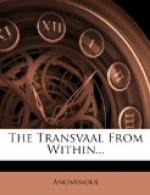This is another carefully designed burden upon the mines and country. The issued capital and loans of the Netherlands Company now total about L7,000,000, upon which an average interest of about 5-1/3 per cent.—guaranteed by the State—is paid, equal to L370,000 per annum. Naturally the bonds are at a high premium. The Company and its liabilities can be taken over by the State at a year’s notice, and the necessary funds for this purpose can be raised at 3 per cent. An offer was recently made to the Government to consolidate this and other liabilities, but the National Bank, which is another concession, has the monopoly of all State loan business, and this circumstance effectually disposed of the proposal. At 3 per cent. a saving of L160,000 per annum would be made in this monopoly in interest alone. The value represented by the Custom dues on the Portuguese border we are not in a position to estimate, but roughly these collections and the 15 per cent. of the profits paid to the management and shareholders must, with other leakages, represent at least another L100,000 per annum, which should be saved the country. As the revenue of the corporation now exceeds L2,000,000 a year, of which only half is expended in working costs, the estimate we have taken does not err upon the side of extravagance. By its neglect of its duties towards the commercial and mining community enormous losses are involved. Thus, in the coal traffic, the rate—which is now to be somewhat reduced—has been 3d. per ton per mile. According to the returns of the Chamber of Mines, the coal production of the Transvaal for 1895 was 1,045,121 tons. This is carried an average distance of nearly thirty miles, but taking the distance at twenty-four miles the charges are 6s. per ton. At 1-1/2d. per ton per mile—three times as much as the Cape railways charge—a saving upon the coal rates of 3s. per ton would follow, equal to L150,000 per annum. Again, by the ‘bagging’ system, an additional cost of 2s. 3d. per ton is incurred—details of this item have been recently published in this paper—and if this monopoly were run upon ordinary business lines, a further saving of L110,000 would be made by carrying coal in bulk. The interest upon the amount required to construct the necessary sidings for handling the coal, and the tram-lines required to transport it to the mines, would be a mere fraction upon this amount; and as the coal trade in the course of a short time is likely to see a 50 per cent. increase, the estimate may be allowed to stand at this figure without deduction. No data are available to fix the amount of the tax laid upon the people generally by the vexatious delays and losses following upon inefficient railway administration, but the monthly meetings of the local Chamber of Commerce throw some light upon these phases of a monopolistic management. The savings to be made in dealing with the coal traffic must not be taken as exhausting all possible reforms; the particulars given as to




